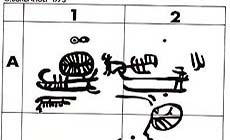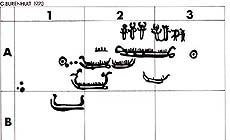 |
Description: |
Engravings
Paintings
Painted engravings
High or low-relief
Sculpture
Skälv panels 6 & 7D, Borg parish, Östergötland. The locality consists of a number of panels with rock carvings. On panel no 6 there are c. 5 ship figures, 3 double-lined with crew strokes, 1 single-lined, and one double-lined without crew strokes. The largest ship has an extended keel-line, perhaps a steering-oar and an extended and upturned prow. Over the gunwale there is an oval superstructure with frame-strokes, could be a sail. There is 1 human figure, some cup marks and a number of obscure figures, possibly fragmentary frame-figures. Panel no 7D: There are 6 ship figures, of which one double-lined without crew strokes, with stem and stern turned up-and inwards, 4 double-lined with crew strokes. There is 1 single-lined ship with 4 crew strokes. There are 2 circle figures with 1 cup mark in the middle, and 6 cup marks distributed over the surface. There are 7 human figures forming a procession. The human figures are wearing horned helmets and the arms are raised.
|
Figures: |
Ship figures/double-lined with crew strokes/without crew strokes/single-lined
Human figure
Circle figure
Frame figures (?)
Cup marks
|
|
 |
Chronology: |
Palaeolithic
Epipalaeolithic - Mesolithic
Neolithic
Copper Age
Bronze Age
Iron Age
Roman
Middle Age
Modern
Unknown
The rock carvings in Östergötland are generally dated to the Bronze Age, c. 1800-500 BC on basis of the position in the landscape, the relation to other ancient monuments and of the combinations of different figures and motifs. Bronze Age, Carving, Rock art, Open air, Wheel cross, Human figures, Horsemen, Dancer, Weapon, Axes, Shafted dagger, Ceremonial, Megalithic, Ship figures, Cup marks.
|
Notes: |
The province of Östergötland in Sweden, has long been well-known for its profusion of rock carvings, but figurative carvings only abound in a small area to the W of Norrköping; elsewhere they are few and far between. It is probable that the Norrköping district was of importance as a religious centre on several spatial and social levels in a tribal society: local, regional and supra-regional; perhaps with Ekenberg functioning on the highest level. The widespread cup mark sites, on the other hand, were utilised for a domestic cult on a microlevel, probably prevailing into the Iron Age and perhaps longer (Selinge 1989:234). |
|
 |
 NEW: Alpine rock paintings
NEW: Alpine rock paintings

